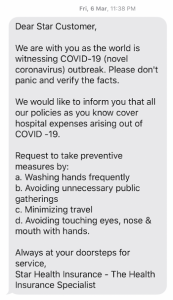What if I told you that your best performing and the highest engaging channel is one that you don’t even use? As you’ve probably figured out from the title, I’m talking about direct mail marketing.
Direct mail has some of the highest response rates and competitive cost-per-acquisition across most marketing channels including digital ones like email, social, and display advertising. If you’re still skeptical, here’s some data that might convince you otherwise.
How Direct Mail Marketing Outperforms Other Digital Tactics
From the DMA Response Rate Report 2015
- Direct mail achieves a 3.7% response rate with a house list and a 1.0% response rate with a prospect list. All digital channels combined only achieve a 0.62% response rate
- Cost-per-acquisition for direct mail is very competitive at $ 19, compared to Email ($ 11-15), Social Media ($ 16-18), Paid Search ($ 21-30)
- Direct mail offers a strong return on marketing investment with the same ROI as social media (15-17%)
From the DMA 2015 Statistical Fact Book
- Of people who receive direct mail, 42.2% of recipients either read or scan it, while only 22.8% say they don’t read it
- Mail volume has been steadily decreasing, down by 35% over the past decade, which makes it easier to stand out
Now as a marketer you probably have two follow-up questions:
- How do I know if direct mail marketing is right for my business?
- How do I build an effective direct mail marketing campaign?
To address the former, we hosted a webinar with our partner and direct mail experts, Printing for Less (PFL). To help address the second question, we teamed up with our friends at Firewood Marketing to bring you this comprehensive guide to creating a direct mail marketing campaign.
How To Create A Direct Mail Marketing Campaign
As with any marketing effort, there are few critical questions you need to address prior to launching a campaign. Here’s a great visual from Firewood Marketing that highlights the six key factors that impact direct mail performance.

To see a high-res version of the image, right-click the image and open in a new tab
Defining Direct Mail Marketing Goals
Direct mail marketing campaigns can lead to a number of beneficial outcomes, such as increased lead volume, site traffic, demo signups, sales, and more. But before you walk through the content and logistics of your campaign, it’s important to determine which objectives matter most.
Here’s a list of questions you can use to organize and launch your direct mail campaign:
- What is your budget? Have you allocated enough resources to various marketing channels?
- Are you willing to try direct mail more than once? Note: Mailing regularly is a requirement of successful direct mail campaigns
- Do you have enough time to appropriately plan your campaign details? Have you thought about creatives, call-to-actions, design, and personalization?
- Do you have the data you need to launch a targeted campaign? Have you segmented your audience?
- Is your direct mail campaign going to a large enough group to test results? Note: A/B testing is relevant for non-digital channels as well
If you don’t have answers for all these questions yet, that’s okay. It’s important to have a solid understanding of your market, define clear objectives for your campaign, have a product that is mature enough to appeal to a broad audience, and most importantly have patience (this isn’t email).
Examples of Direct Mail Marketing Objectives
As you think about your direct mail objectives, remember that direct mail isn’t a ‘one-and-done’ tactic, and it should be part of an integrated marketing approach. So your objectives can (and should) vary based on your prospects and their stage in the buyer’s journey.
Here are some examples to help you get started:
- To generate 200 new sales leads over 8 weeks
- To get 300 prospects to my landing page and sign up for a webinar
- To have 50 prospects call our office to set up an in-person demo or meeting
- To cross-sell new products to 25 customers
- To have 100 people download our eBook from our website
Firewood Direct Mail Marketing Tip #1: Your direct mail piece should include a clear, simple call-to-action that directly aligns with your marketing goals. So if your goal is primarily lead capture, it would make sense to direct your prospects to fill out an online form. But if you are trying to make an immediate sale (and you have the kind of product that doesn’t require a long sales cycle), only providing a phone number for response may generate a better close rate.
Determine Cost-Benefit Analysis
If this is your first time launching a direct mail campaign, or you’re interested in testing out the performance of direct mail against digital channels, a cost-benefit analysis is a handy way to measure the results of your campaign.
But putting together the exact cost for a direct mail campaign can be challenging since there are many variable costs, including:
- Design / collateral
- Number of recipients
- Type of mailing (postcard, large envelope, etc.)
- Postage (first class, standard, presorted, etc.)
Overall costs can vary greatly for a direct mail campaign.
Most successful campaigns yield a 1-5% response rate, but you need to look beyond this metric. Tracking other metrics like conversion rates, which represents the number of respondents that convert to paying customers, is another important metric to track.
Firewood Direct Mail Marketing Tip #2: Direct mail is an effective but expensive prospecting channel. That’s why it’s important to factor in the lifetime value of a new customer – not just the immediate CPA – when doing a cost-benefit analysis.
Targeting Your Best Audience

Consumption habits and conversion rates can vary drastically between verticals and audience segments. When building out your mailing list, it’s important to take into account your target personas, identify which stage of the buying cycle they’re in, and then align your direct mail offers to prospects accordingly.
The best practice is to build out segments of your target accounts and use fit, behavioral, and intent data (from your CRM, marketing automation, and predictive platforms) to ensure you’re reaching the right audience. A big misconception with direct mail is that it’s a “one-size-fits-all” channel. On the contrary, direct mail nowadays (like other marketing channels) is about personalized and timely offers that target custom lists based on all available customer and prospect data.
Why Using Predictive Simplifies Direct Mail Marketing Campaigns
It would be remiss of us to not talk about the data behind your campaign since it’s one of the most critical elements of your marketing efforts.
If this is your first campaign, it will be extremely helpful to take stock of the success you’ve had on other channels – digital advertising, organic user growth, social media, etc. – and expand on that success with direct mail.
Your campaign is only as good as the data supporting it, and predictive can elevate your campaign results with more targeted outreach. Marketers can use predictive signals such as company size, region, web presence, etc. to get more details into audience segments, allowing for better personalization.
Predictive also enables marketers to identify “look-alikes” or accounts with attributes similar to their existing customers, to identify new leads in their CRM that have never been reached before.
Firewood Direct Mail Marketing Tip #3: The key to direct mail success is targeting the right prospect at the right time. Use trigger events (like relocation, close of funding rounds, new hires, promotions, etc.) in conjunction with other targeting variables to maximize marketing relevancy and success.
Deciding What to Send
When thinking about your direct mail offer and what you should send, use principles like the AIDA formula (see below) to prepare clear copy and a desirable offer.
A – attention (awareness): attract the attention of the prospect / customer
I – interest: raise interest by focusing on and demonstrating advantages and benefits (instead of focusing on features)
D – desire: convince customers that they want and desire the product or service and that it will satisfy their needs
A – action: lead customers towards action and/or purchase decisions
If you’re still struggling with building an offer, start with a simple thought exercise of writing a letter to your prospect. This will help clarify what you want to express, then build out your offer with the AIDA formula.
Firewood Direct Mail Marketing Tip #4: Unusual formats, shapes, and sizes can help your message to stand out in the mailbox and get noticed. But be careful about getting too “quirky” or you may not be taken seriously.
Crafting a Compelling Call-To-Action (CTA)
Similar to your digital efforts, it’s important to include a clear and compelling CTA in your mailer. Remember: The direct mail offer is just one step in the buyer’s journey. So be sure to share a logical “next step” for your prospects.
For example, direct your recipients to a specific landing page, which can make it easy for them to find more information, and also help you track the success of your campaign.
Creating Direct Mail Offers
The offer is an important part of your direct mail campaign, after all, it incentivizes your prospects to take a favorable action. When creating your offer, refer back to the direct mail objectives you defined earlier and consider all relevant audience information.
Your offers can vary greatly based on the prospects you’re targeting and the campaign’s intended goal. Here are some examples to help get you started:
- Early bird discounts or special introductory prices to boost sales
- Free gifts and samples to increase brand awareness
- Free reports or eBooks to generate leads
- ‘Recommend a friend’ offers to grow your subscription base
- Loyalty programs to encourage upsells and cross-sells
You could also team up with a partner company to offer their product in return for trying out yours. For example, offering an Amazon or Visa gift card to respondents that fill out a survey.
Firewood Direct Mail Marketing Tip #5: A direct mail piece with a clear offer will outperform one without. But to maximize lead quality, you’ll want to tie the offer directly to your product or service (think free trial or percentage off) rather than gift cards, cash, or other non-relevant offers.
Printing and Mailing Logistics
It shouldn’t come as a surprise that printing and mailing are a big part of your direct mailers. If you’re new to direct mail and need some help, use the information below to guide your mailing efforts.
Printing
If you’ve ever had business cards printed you most likely are familiar with the importance of color matching, paper types, and straight cuts. But there are two overarching tips you should keep in mind to help jumpstart your printing efforts smoothly:
- Build relationships: If you’re serious about direct mail and plan on running several mailings, start building relationships at a few print shops. You need multiple contacts just in case one of them is too busy to handle your campaign needs. Note: The print shop doesn’t have to be local, but they should ideally be accessible, have the bandwidth to handle last-minute changes, and deliver on time.
- Ask for references: As you look for new contacts, reach out to any partners or companies that have done direct mailers in the past. Or, ask your print shop of choice to direct you to reference customers. Use these references to ensure your print shop delivers high-quality mailers on time. Get additional information to help address any questions you might have about the process, especially if this is your first direct mail campaign.
Mailing
If you’re only sending postcards or something simple, then you can take them from the printer to the post office. But if your mailers require folding, envelopes, order forms and more, you probably need to enlist the help of a Mail Processing Facility.
A Mail Processing Facility will take all of your materials, put them together, and send them off via USPS. Standard practice dictates that the facility will provide a quote from USPS for the shipping. Note: It’s also often suggested that you should issue a check payable to USPS for the amount of the quote – to ensure your payment is going to the postal service and no one else.
Firewood Direct Mail Marketing Tip #6: There are a lot of small, but incredibly important, steps that will either make or break the accurate production, personalization, and mailing of a direct mail campaign. To avoid common pitfalls, choose a printer who specializes in direct mail, and let them guide you.
Measuring Success

Measuring the success of your direct mail campaign doesn’t have to be tricky. Use the tips outlined below to simplify measuring the performance of your mailers.
Testing Different Offers
Similar to other marketing campaigns, it’s important to test out various offers, CTAs, headlines, images, and other aspects of your mailers. The most successful tests experiment with a specific area of the mailer. Some examples include:
- Offers: offer a cash discount ($ 10) or a percentage discount (10%)
- Calls to Action: ask one group of recipients to call, and ask the other group to email
Similar to A/B testing in digital channels, testing your mailers can ensure that your next campaign outperforms the first one.
Coding Mailers To Track Responses
Although your mailer is going out in a non-digital channel, you can still track responses to your campaign by assigning each mailing a batch number. Adding specific calls to action to your mailers helps you calculate the total response, and adding unique codes to your mailers helps you easily track individuals response.
To collect responses using codes, you can set up a unique campaign URL, email address, or phone number that invites respondents to enter their unique codes. For example www.yourbusiness.com/09141783

Note: Some companies use codes effectively by inviting recipients to visit a website to enter a raffle, fill out a questionnaire, or collect a prize.
Firewood Direct Mail Marketing Tip #7: In addition to using unique URL, phone numbers and the like to track responses, always do at least one match back after every campaign to correctly attribute prospects who were impacted by your direct mail campaign, but chose to respond via non-trackable channels (like through your home page, or at a brick-and-mortar location).
Calculating ROI
When measuring the return on investment (ROI) of your campaign, you need to take multiple factors into account. Here’s a list of variables you should consider when calculating the ROI for your direct mail campaign:
- Campaign audience size
- Cost per mailing
- Total campaign budget
- Response rate
- Conversion rate
- Number of buyers
- Average revenue per buyer
- Revenue generated
- Profit generated
Let’s look at an example calculation to better understand how you can calculate your campaign ROI. For the sake of this illustration, we’ll simplify the example by assuming:
Revenue – Campaign Costs = Profit
Results of the campaign
- Campaign audience size = 5,000
- Cost per mailing = $ 0.60
- Total campaign budget = $ 3,000
- Response rate = 1.4%
- Conversion rate = 92.9%
- Number of buyers = 5,000 * 1.4% * 92.9% = 65
- Average revenue per buyer = $ 100.00
- Revenue generated = $ 6,500
- Profit generated = $ 3,500
Using the data above, we can calculate ROI by looking at Profit / Total campaign budget:
$ 3,500 / $ 3,000 = 116.7%
As you can see from this scenario, even with a very low response rate, you can achieve a high ROI with direct mail marketing.
Note: To track and measure success, you should add all recipients of your mailers to your CRM. If you use Salesforce, using the “Campaign” object is an easy way to attribute revenue to certain marketing campaigns.
Firewood Direct Mail Marketing Tip #8: Always use lifetime value (LTV) when calculating direct mail ROI. While often more expensive to acquire, in our experience direct mail-sourced customers can often have a significantly higher LTV than customers sourced through other channels.
Recap & Getting Started
This can be a lot of info to take in, so here’s a quick rundown of the key factors for direct mail success:

Now that we’ve covered the basics, it’s time to put everything you’ve read into practice.
Creating a high-performing direct mail campaign takes time and effort, so be persistent. And, keep an eye out for these common pitfalls.
It might be intimidating to keep sending your mailers to the same address when you don’t receive a response, but remember that timing is a critical part of any marketing process. If you build your campaign on accurate business data, target the right audience segment, and personalize your offers to resonate with prospects, then you should have the confidence to continue sending mailers until you convert the address to a customer.
Firewood Direct Mail Marketing Tip #9: Just like any online marketing effort, be prepared to test, learn, and test again. It is rare that any direct mail campaign will be successful right out of the gate, so allow a minimum of 6 months to a year of focused testing before deciding whether direct mail is right for you and your marketing efforts.
Business & Finance Articles on Business 2 Community
(116)
Report Post





